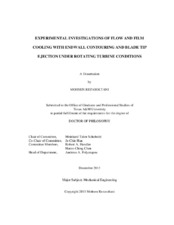| dc.description.abstract | Very limited experimental data is available for aerodynamic and film cooling effectiveness under rotating condition in the literature. As a result, there is a strong need to study in detail and discover essential features of turbine platform and blade tip film cooling under engine representative flow and rotating conditions. This dissertation deals with the specific heat transfer and aerodynamics problematic inherent to high pressure (HP) turbine sections.
Major efficiency improvement has been achieved by introducing a completely new endwall contouring technology which decreases the strength of the secondary flow vortices. Efficiency measurements show for the contoured rotor a maximum efficiency of 89.9% compared to the reference non-contoured case of nt-s = 88.86%. This is an efficiency increase of nt-s = 1.04%.
The new method of endwall contouring not only has improved the turbine aerodynamic efficiency but it also has substantially improved the film cooling effectiveness of the contoured endwall. The film cooling experiments were carried out using pressure sensitive paint (PSP) measurement technique. Measurements were conducted for three coolant-to-mainstream mass flow ratios (MFR) of 0.5%, 1.0% and 1.5%. Film cooling data is also obtained for three rotational speeds, 3000 rpm (reference condition), 2550 rpm and 2400 rpm and they are compared with non-contoured endwall data. For 3000 rpm two more coolant to mainstream mass flow ratio of 0.75% and 1.25% are performed to have a better view of how film cooling effectiveness is changing. Comparing experimental results of the film cooling effectiveness investigations of the contoured case with the reference non-contoured case, clearly shows the improving effect of contouring on film cooling effectiveness for all cases investigated in this report.
Four different blade tip ejection configurations were utilized to determine the impact of the hole arrangements on the film cooling effectiveness: plane tip with tip hole cooling, squealer tip with tip hole cooling, plane tip with pressure-side-edge compound angle hole cooling and squealer tip with pressure-side-edge compound angle hole cooling. To avoid rotor imbalance, every pair is installed radially. Film cooling effectiveness measurements were performed for three blowing ratios (M) of 0.75, 1.25 and 1.75. Film cooling data was also obtained for three rotational speeds; 3000 rpm (reference condition), 2550 rpm and 2000 rpm. Film cooling measurements were performed using pressure sensitive paint (PSP) technique.
The experimental investigations were performed in the three-stage multi-purpose turbine research facility at the Turbomachinery Performance and Flow Research Laboratory (TPFL), Texas A&M University. | en |


